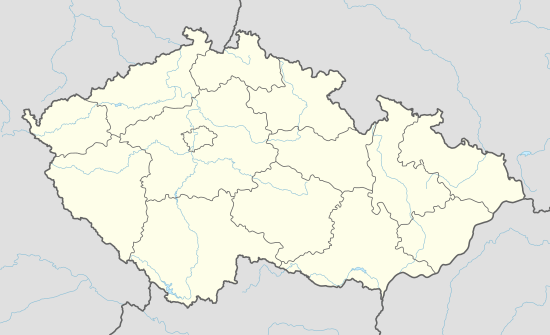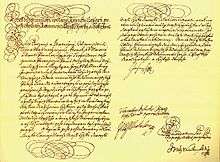Czech Technical University in Prague
| České vysoké učení technické v Praze | |
 | |
| Motto | Scientia est potentia (Latin) |
|---|---|
Motto in English | Knowledge is power |
| Type | Public |
| Established | 1707, Kingdom of Bohemia |
| Rector | Petr Konvalinka |
Administrative staff | 1777 (2011) |
| Students | 23,185 (2011) |
| Location |
Prague, Czech Republic (main campus), additional 4 smaller campuses Coordinates: 50°6′7.8″N 14°23′18.5″E / 50.102167°N 14.388472°E |
| Website |
www |

Czech Technical University in Prague (Czech: České vysoké učení technické v Praze, ČVUT) is one of the largest universities in the Czech Republic, and is one of the oldest institutes of technology in Central Europe. It is also the oldest non-military technical university in Europe.[1]
In the academic year 2012/2013 8 faculties and 1 university institute of Czech Technical University offered 105 degree programs and 419 fields of study, which enrolled more than 24,500 students.
History

It was established as the Institute of Engineering Education in 1707, but not as a tertiary university but only secondary education (high school), by Emperor Joseph I[2] as a response to Christian Josef Willenberg's petition addressed to preceding emperor Leopold I. In 1806 the institute of Engineering Education was transformed into Prague Polytechnical Institute (or Prague Polytechnic), when the university studies began. After the disintegration of the Austro-Hungarian Empire, the name of the school was changed in 1920 to the Czech Technical University in Prague.
Origins
In 1705, Christian Josef Willenberg asked Emperor Leopold I for permission to teach "the art of engineering". Later, the emperor's only son, who succeeded him on the throne in 1707 as Joseph I, ordered the Czech state of Prague to provide engineering education. Due to various reasons the request was avoided long periods of time but in October 1716 Willenberg repeated the request and finally on 9 November 1717 a decree by the Czech state granted Willenberg the professorship (first engineering professorship in Central Europe) and on 7 January 1718 he began teaching. Initially, Willenberg started teaching only 12 students in his own apartment (six barons , four knights and two burghers), but gradually students proliferated (in 1779 there were around 200) and they started studying in more suitable premises. Initially, the training focused mainly on the military. Teaching in the first year lasted one hour per day in the second year almost two.
The successor of prof. Willenberg was Johann Ferdinand Schor, builder of hydraulic structures in the basin of the Vltava and author of textbooks used at the school of mathematics. He began under Willenberg's leadership by teaching optics, perspectivity, technical drawing and geography. The third was professor František Antonín Herget, who mainly focused on civil engineering, particularly construction.
In September 1776 Maria Theresa allowed Herget to use the Clementinum building; in 1786 the school moved to the new and better building.
In 1787 the School of Engineering was established at the decree of Emperor Joseph II.
Constituent parts
Faculties
- Faculty of Civil Engineering
- Faculty of Mechanical Engineering
- Faculty of Electrical Engineering
- Faculty of Nuclear Sciences and Physical Engineering
- Faculty of Architecture
- Faculty of Transportation Sciences
- Faculty of Biomedical Engineering
- Faculty of Information Technology
Higher education institutes
- Klokner Institute
- Masaryk Institute of Advanced Studies
- University Centre for Energy Efficient Buildings
Other institutes
- Computing and Information Centre
- Technology and Innovation Centre
- The Research Centre for Industrial Heritage
- Institute of Experimental and Applied Physics
- Centre for Radiochemistry and Radiation Chemistry
- Division of Construction and Investment
Service facilities
- ČVUT Rector's Office
- Service Facilities
- Publishing House
Student clubs, ČVUT Student Union
Student clubs within the ČVUT are integrated in the Student Union. It has 27 members and covers wide range of free time activities, with biggest club called Silicon Hill. The Student Union also organizes social events for students through the year.
Notable alumni
- František Běhounek, radiologist
- Christian Doppler, mathematician and physicist
- Martin Holub, architect
- Josef Gerstner, physicist and engineer
- Eva Jiřičná, architect
- Karel Jonáš, who became Charles Jonas (Wisconsin politician), Czech-American publisher, legislator and Lieutenant Governor of Wisconsin
- Karl Kořistka, geographer and technologist
- František Křižík, inventor, electrical engineer and entrepreneur
- Vladimir Prelog, chemist and Nobel Prize winner
- Emil Weyr, mathematician
- George Klir, computer and systems scientist
- Emil Votoček, chemist
- Josef Zítek, architect and engineer
Photos
 The ČVUT Rectorate
The ČVUT Rectorate Dejvice campus
Dejvice campus Karlovo Náměstí campus
Karlovo Náměstí campus Bethlehem Chapel – The ČVUT's ceremonial hall
Bethlehem Chapel – The ČVUT's ceremonial hall Dejvice campus - Library, FCE, FA
Dejvice campus - Library, FCE, FA Interior of National Technical Library
Interior of National Technical Library
Notes and references
External links
| Wikimedia Commons has media related to Czech Technical University. |
- Official website
- www.StudyAtCTU.com Official website for international students
- Faculty of Civil Engineering
- University Centre for Energy Efficient Buildings (UCEEB)
- Top Industrial Managers for Europe (TIME) network for student mobility.
- School of Applied and Engineering Physics
- Tereza Centre (Czech)